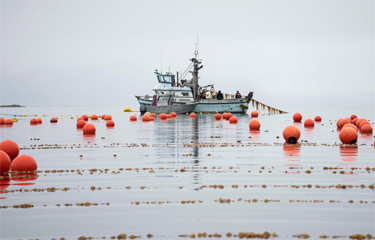NOAA is considering the creation of an aquaculture opportunity area in the U.S. state of Alaska, the agency announced 1 June.
Alaska could become the third region with an aquaculture opportunity area (AOA), joining Southern California and the Gulf of Mexico, though Alaska's is likely to be declared in state waters, whilethe previous two AOAs are in federal waters.
AOAs have been evaluated as suitable sites for future to aquaculture development. While AOAs do not count as preapproved for aquaculture use – developers will still need to go through state and federal permitting – they signal to potential growers that a site is well-suited for aquaculture.
NOAA and the state of Alaska will only be looking at aquaculture opportunities for marine invertebrates like sea cucumbers, seaweed, and shellfish. Finfish aquaculture will not be considered, as it is illegal in Alaska state waters.
“These areas will be identified through a science-based public process that allows constituents to share their community, tribal, and stewardship goals for aquaculture development in Alaska coastal waters,” NOAA Fisheries Director of Aquaculture Danielle Blacklock told reporters. “Over the coming years, NOAA’s national centers for coastal ocean science will use ecosystem modeling to inform the size and location for potential AOAs based on environmental, economic, and cultural data.”
Ultimately, the agency will produce a publicly available atlas that will be used as part of a comprehensive environmental review, Blacklock said. NOAA Fisheries will then solicit public comments on potential AOAs.
“With an AOA, they will know in advance of applying which areas to avoid," Alaska Department of Fish and Game Commercial Fisheries Director Sam Rabung said.
“That’s the biggest value of this exercise,” Rabung added. “We’re going to identify areas of potential conflict in advance.”
Members of the Alaska state legislature, Alaska Governor Mike Dunleavy, native organizations, and state-based industry and research institutions asked NOAA to consider Alaska for AOAs during a public comment period in 2020.
“I appreciate NOAA’s decision to begin working with the state to identify AOAs in Alaska,” Dunleavy said in a statement. “This sector has huge growth potential and will provide yet another example of Alaskan leadership in the seafood industry.”
The state has a goal of establishing a USD 100 million (EUR 93 million) aquaculture industry by 2040. Alaska aquaculture production sales totaled USD 1.9 million (EUR 1.8 million) in 2022.
“Alaska presents a really exciting opportunity to show how dynamic this planning process can be,” Blacklock said.
NOAA Fisheries announced the first two AOA regions – federal waters off the coast of Southern California and in the Gulf of Mexico – in 2020 following an executive order by then-U.S. President Donald Trump pushing for more domestic aquaculture production. The order required NOAA to identify a minimum of two AOA regions with a goal of establishing 10 AOAs by 2025.
In 2021, NOAA Fisheries announced it had identified nine potential AOAs in the Gulf of Mexico and 10 in Southern California.
However, the process has faced backlash from environmental groups. In April 2023, protesters voiced opposition to aquaculture outside NOAA’s offices in Long Beach, California, following the release of a scoping report for AOAs.
“The pollution surrounding fish farm sites such as these can create dead zones where there isn’t enough oxygen in the water to support even basic marine life,” Santa Barbara-Ventura Sierra Club Chair Katie Davis told the Santa Barbara Independent. “Developing fish farms off the coast of Santa Barbara is an ecological disaster just waiting to happen.”
Fishermen in Southern California have also vocally opposed establishing aquaculture sites in federal waters off the coast of Southern California.
“We strongly oppose the conversion of fishing grounds to aquaculture farms,” the Commercial Fishermen of Santa Barbara told NOAA in a letter. “Our industry has already suffered major loss of valuable grounds and access from decades of dramatic regulatory reform, marine protected area closures, oil spills, and oil and gas infrastructure, and new challenges on the horizon in the form of giant wind farms, associated cables, a new national narine sanctuary, and the state’s 30x30 initiative.”
“We do not support taking more grounds away to experiment with new installations that have a very mixed track record of success in our waters,” the group said. “Past aquaculture installations in California have littered the sea floor with trash that was never recovered, gone out of business, and led to loss of human life.”
Photo courtesy of Seagrove Kelp







